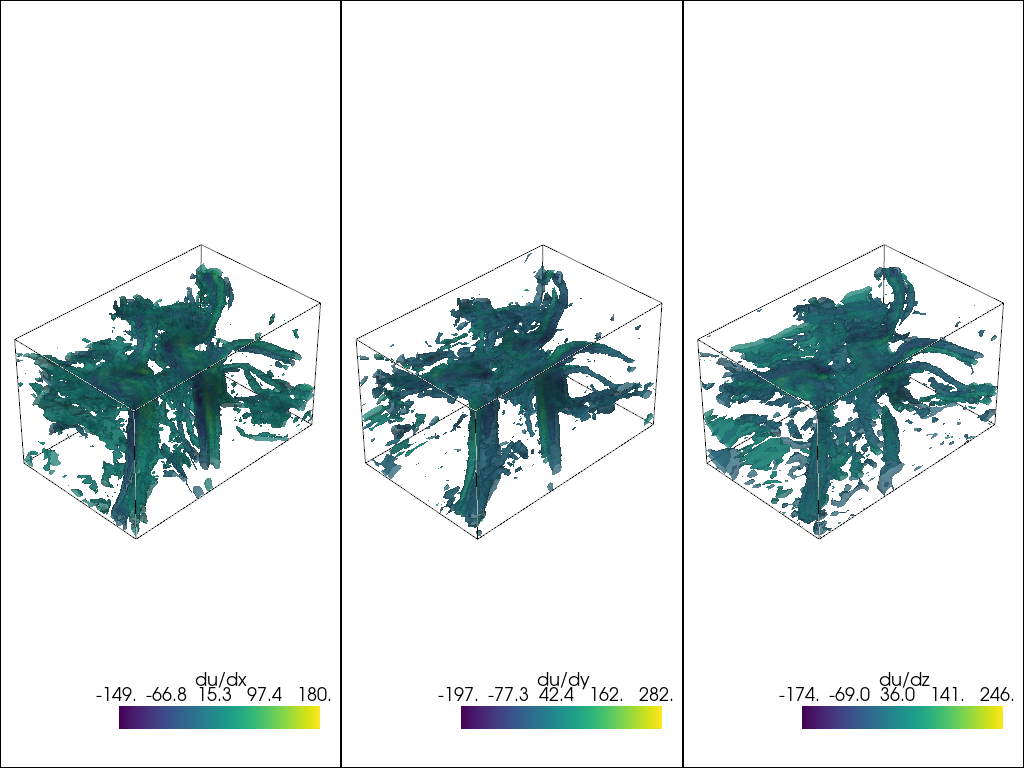Note
Go to the end to download the full example code.
Compute Gradients of a Field#
Estimate the gradient of a scalar or vector field in a data set.
The ordering for the output gradient tuple will be {du/dx, du/dy, du/dz, dv/dx, dv/dy, dv/dz, dw/dx, dw/dy, dw/dz} for an input array {u, v, w}.
Showing the pyvista.DataSetFilters.compute_derivative() filter.
Now compute the gradients of the vectors vector field in the point data
of that mesh. This is as simple as calling
pyvista.DataSetFilters.compute_derivative().
mesh_g = mesh.compute_derivative(scalars='vectors')
mesh_g['gradient']
pyvista_ndarray([[ 7.21899979e-03, 7.65699986e-03, 3.87999974e-03,
..., -7.38500012e-03, 1.00600009e-03, -2.10000435e-05],
[ 4.28850017e-03, 9.30000097e-04, -6.55200006e-03,
..., -6.13999972e-03, 3.67700006e-03, 1.17300004e-02],
[ 5.40149957e-03, 1.25399977e-03, -4.65100026e-03,
..., 3.49000096e-04, 8.01400002e-03, 8.14399961e-03],
...,
[ -6.39999984e-04, -2.63400003e-03, 6.17399998e-03,
..., -4.32049995e-03, -1.22299988e-03, -1.89600000e-03],
[ -1.59000000e-03, -3.44600016e-03, 4.12799977e-03,
..., -2.89999996e-03, -5.99600002e-03, -5.81400003e-03],
[ -9.11999959e-04, -4.06700000e-03, -1.58199994e-03,
..., -2.47599976e-03, -8.52899998e-03, -5.39399963e-03]], dtype=float32)
Note
You can also use pyvista.DataSetFilters.compute_derivative() for
computing other derivative based quantities, such as divergence, vorticity,
and Q-criterion. See function documentation for options.
mesh_g["gradient"] is an N by 9 NumPy array of the gradients, so we
could make a dictionary of NumPy arrays of the gradients like:
def gradients_to_dict(arr):
"""Label the gradients into a dictionary."""
keys = np.array(
['du/dx', 'du/dy', 'du/dz', 'dv/dx', 'dv/dy', 'dv/dz', 'dw/dx', 'dw/dy', 'dw/dz'],
)
keys = keys.reshape((3, 3))[:, : arr.shape[1]].ravel()
return dict(zip(keys, mesh_g['gradient'].T))
gradients = gradients_to_dict(mesh_g['gradient'])
gradients
{'du/dx': pyvista_ndarray([ 0.007219 , 0.0042885, 0.0054015, ..., -0.00064 ,
-0.00159 , -0.000912 ], dtype=float32), 'du/dy': pyvista_ndarray([ 0.007657, 0.00093 , 0.001254, ..., -0.002634,
-0.003446, -0.004067], dtype=float32), 'du/dz': pyvista_ndarray([ 0.00388 , -0.006552, -0.004651, ..., 0.006174,
0.004128, -0.001582], dtype=float32), 'dv/dx': pyvista_ndarray([ -7.59999966e-04, -1.05850003e-03, -2.95999995e-03, ...,
-1.95549987e-03, 9.99998883e-06, 2.66000000e-03], dtype=float32), 'dv/dy': pyvista_ndarray([ 0.000226, -0.00503 , -0.003388, ..., -0.0059 ,
-0.008274, -0.000512], dtype=float32), 'dv/dz': pyvista_ndarray([-0.006821, -0.000382, 0.006909, ..., -0.001991,
-0.003061, -0.00189 ], dtype=float32), 'dw/dx': pyvista_ndarray([-0.007385 , -0.00614 , 0.000349 , ..., -0.0043205,
-0.0029 , -0.002476 ], dtype=float32), 'dw/dy': pyvista_ndarray([ 0.001006, 0.003677, 0.008014, ..., -0.001223,
-0.005996, -0.008529], dtype=float32), 'dw/dz': pyvista_ndarray([ -2.10000435e-05, 1.17300004e-02, 8.14399961e-03, ...,
-1.89600000e-03, -5.81400003e-03, -5.39399963e-03], dtype=float32)}
And we can add all of those components as individual arrays back to the mesh by:
keys = np.array(list(gradients.keys())).reshape(3, 3)
p = pv.Plotter(shape=keys.shape)
for (i, j), name in np.ndenumerate(keys):
p.subplot(i, j)
p.add_mesh(mesh_g.contour(scalars=name), scalars=name, opacity=0.75)
p.add_mesh(mesh_g.outline(), color='k')
p.link_views()
p.view_isometric()
p.show()

And there you have it, the gradients for a vector field. We could also do
this for a scalar field like for the scalars field in the given dataset.
mesh_g = mesh.compute_derivative(scalars='scalars')
gradients = gradients_to_dict(mesh_g['gradient'])
gradients
{'du/dx': pyvista_ndarray([-7. , -7. , -4. , ..., -0.5, -1.5, -2. ], dtype=float32), 'du/dy': pyvista_ndarray([ 0., 5., 12., ..., -3., -1., -3.], dtype=float32), 'du/dz': pyvista_ndarray([-13., -8., -3., ..., 4., 4., 1.], dtype=float32)}
mesh_g.point_data.update(gradients)
keys = np.array(list(gradients.keys())).reshape(1, 3)
p = pv.Plotter(shape=keys.shape)
for (i, j), name in np.ndenumerate(keys):
p.subplot(i, j)
p.add_mesh(mesh_g.contour(scalars=name), scalars=name, opacity=0.75)
p.add_mesh(mesh_g.outline(), color='k')
p.link_views()
p.view_isometric()
p.show()

Total running time of the script: (0 minutes 3.426 seconds)